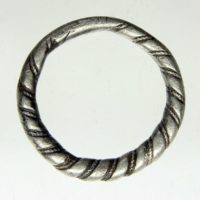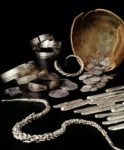 A rare silver Viking ring was acquired by the Rijksmuseum van Oudheden (RMO) in Leiden just before it had to close its doors last month. A metal detectorist found it in a cornfield near Hoogwoud in the province of Noord Holland on Christmas Day 2019. It was bought quickly from the finder for an undisclosed sum and is now part of the national collection.
A rare silver Viking ring was acquired by the Rijksmuseum van Oudheden (RMO) in Leiden just before it had to close its doors last month. A metal detectorist found it in a cornfield near Hoogwoud in the province of Noord Holland on Christmas Day 2019. It was bought quickly from the finder for an undisclosed sum and is now part of the national collection.
With a diameter of 25mm, a tiny hair under an inch, and weighing eight grams, the ring is quite large. It was made by twisting two silver wires, one thicker, one fine filigree thread made with tiny balls, together. The braided style was in use by Viking goldsmiths from the 9th through the 11th century A.D. This ring dates to the 10th century.
Danish Viking began raiding The Netherlands in the 9th century, occupying the Dutch coast briefly but they didn’t settle permanently as they did in Ireland or York. They established temporary quarters where they camped out in the winter between raids and sea journeys in what is today the  province of Noord Holland. A Viking silver hoard from the 9th century discovered in Westerklief, less than 20 miles north of Hoogwoud, is now in the collection RMO. There’s a braided silver bracelet in the hoard made using the same technique as the newly acquired ring.
province of Noord Holland. A Viking silver hoard from the 9th century discovered in Westerklief, less than 20 miles north of Hoogwoud, is now in the collection RMO. There’s a braided silver bracelet in the hoard made using the same technique as the newly acquired ring.
The size of ring could mean it was made for a sausage-fingered Viking, but RMO curator Annemarieke Willemsen believes it was actually worn as a pendant. The twisted strands flatten and thin out at the top where it dangled from a chain or tie. The wasn’t happenstance; the ring appears to have been deliberately designed to be a pendant and the wear pattern confirms that it was hung from the thin part.
It looks like a miniature version of the neck torcs that were worn by Viking elite of the time. They too were often made with twisted wires that are thin on one side and then gradually thicken as the braid is woven. Pendants of miniature objects — chairs, axes, swords — were popular in the Viking era.
Objects from the 10th and 11th centuries are rare in the Netherlands. The acquisition of this piece will add significantly to the national collection. The museum is planning to display the ring in a future exhibition.